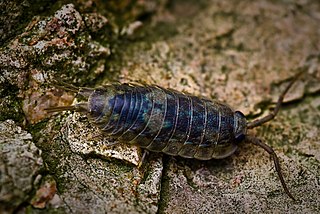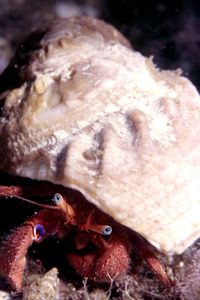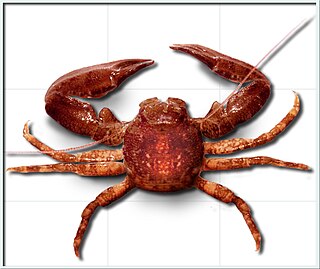 W
WAtergatis floridus, the floral egg crab, green egg crab or shawl crab, is a species of tropical Indo-Pacific crab from the family Xanthidae. The meat of this crab is toxic, even if cooked, and consumption often results in death.
 W
WThe coconut crab is a species of terrestrial hermit crab, also known as the robber crab or palm thief. It is the largest land-living arthropod in the world, with a weight up to 4.1 kg (9.0 lb). It can grow to up to 1 m in length from each tip to tip of the leg. It is found on islands across the Indian Ocean, and parts of the Pacific Ocean as far east as the Gambier Islands and Pitcairn Islands, similar to the distribution of the coconut palm; it has been extirpated from most areas with a significant human population, including mainland Australia and Madagascar.
 W
WCoronula diadema is a species of whale barnacle that lives on the skin of humpback whales and certain other species of whale. This species was first described by Carl Linnaeus in the 1767 12th edition of his Systema Naturae.
 W
WLepas anserifera is a species of goose barnacle or stalked barnacle in the family Lepadidae. It lives attached to floating timber, ships' hulls and various sorts of flotsam.
 W
WLernaeocera branchialis, sometimes called cod worm, is a parasite of marine fish, found mainly in the North Atlantic. It is a marine copepod which starts life as a small pelagic crustacean larva. It is among the largest of copepods, ranging in size from 2 to 3 millimetres when it matures as a copepodid larva to more than 40 mm as a sessile adult.
 W
WLigia oceanica, the sea slater, common sea slater or sea roach, is a littoral woodlouse, living on rocky seashores of the european North Sea and Atlantic coastlines.
 W
WLitopenaeus setiferus is a species of prawn found along the Atlantic coast of North America and in the Gulf of Mexico. It was the subject of the earliest shrimp fishery in the United States.
 W
WPaguristes eremita, the eye spot hermit crab, is a species of hermit crab in the family Diogenidae. It is found in the Mediterranean Sea.
 W
WThe pea crab, Pinnotheres pisum, is a small crab in the family Pinnotheridae that lives as a parasite in oysters, clams, mussels, and other species of bivalves.
 W
WPisidia longicornis, the long-clawed porcelain crab, is a species of porcelain crab that lives in the north-eastern Atlantic Ocean. It varies from reddish to white, and grows to a carapace width of 1 cm (0.4 in). It was first named by Carl Linnaeus in 1767, although the etymology remains unclear.
 W
WSemibalanus balanoides is a common and widespread boreo-arctic species of acorn barnacle. It is common on rocks and other substrates in the intertidal zone of north-western Europe and both coasts of North America.
 W
WThe velvet crab, or alternately velvet swimming crab, devil crab, “fighter crab”, or lady crab, Necora puber, is a species of crab. It is the largest of the swimming crab family (Portunidae) found in British coastal waters. It has a carapace width of up to 100 millimetres (3.9 in), and is the only species in the genus Necora. Its body is coated with short hairs, giving the animal a velvety texture, hence the common name. It is one of the major crab species for United Kingdom fisheries, in spite of its relatively small size.